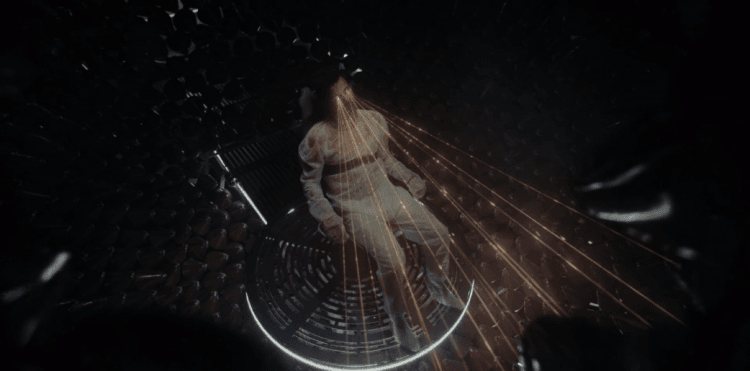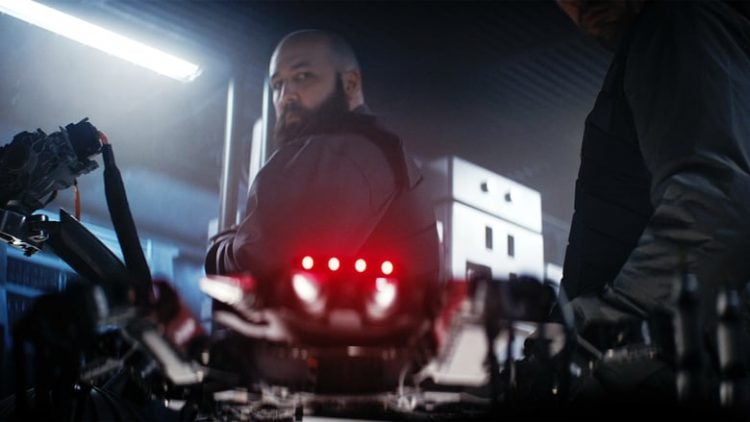
“Everyone’s the same. Darkness and light. Maybe the problem isn’t the terrible things people send out to you but what you let in.”
The Nightflyer crew gear up to hunt the sole telepath on board as Thale’s escape prompts fear and hysteria and, when two crewmen are injured by the L-1, they are looking for their pound of flesh. But as the security forces look to exact their vengeance, system malfunctions continue to occur under their noses and, by the end of it, it’s a certainty that Thale should be the last worry on their minds.

As seen in the previous night’s premiere, the outspoken Murphy Law’s target is the man with the same name. Tossed around during the initial takeoff, Murphy was set aflame at the end of last episode and survives only by Karl and Mel’s quick actions. Though not a primary member of the cast, Murphy’s character represents the crew’s feelings on telepaths and the potential havoc they can cause. Reading the sentiments of his crew, Eris knows that cannot afford to have the distraction and unease Thale represents. It’s exacerbated when Agatha runs across another crew member whose run-in with the L-1 has caused hemorrhaging in a bloody affair that looks worse than it is and an unintentional effect from psychic feedback. Not satisfied with taking him into custody, the Nightflyer security forces are out for blood, ready to eviscerate Thale the first chance they get. If their prejudicial reactions in the first episode weren’t enough to compare telepaths with mutants as seen in the X-Men properties, “Torches and Pitchforks” lays on the hate even thicker.

That’s not to say the crew shouldn’t be concerned. After all, Thale hasn’t exactly endeared himself as an innocent, probing into others’ minds because it’s something he’s expected to do. It’s like the adage of ‘if they see me as a monster, then I’ll be a monster’. For all her years of counseling him, even Agatha doesn’t seem to have the ability to make Thale see that his actions are promoting some of the fear and hate. It’s not until he runs into Tessia, a mysterious (and literal) beekeeper, working in Terraform dome that Thale drops his bravado. In her, he sees someone who isn’t afraid or antagonistic towards him. In fact, she’s able to break through his walls when, in a moment of vulnerability, Thale admits the difficulties of being a telepath. Catching the dark thoughts of so many people around you cannot be an easy thing; in a way, it could be said that Thale’s attitude is not just a self-fulfilling one regarding how people view him, rather it is a reflection of the darkness prevalent in humanity. But does that bombardment excuse Thale’s actions? No it doesn’t, and Tessia tells him as much. Her serenity mirrors that balance seen in nature and, at least for the moment, it seems as if Thale has discovered his North Star.
While much of “Torches and Pitchforks” revolves around the effect Thale and his extraordinary abilities is having towards the Nightflyer crew, the deadlier threat continues to ramp up in the background. Karl’s visions of his daughter continue and whereas Mel was affected in the premiere, Lommie’s hit with disturbing images from her own past, images Thale catches but manifest before and after he’s gone from her presence. Though brief, the abject violence in her visions hints at the reasons behind her aloofness and timidity around people. While her past may be more interesting, it’s the presence she sensed in the system, the ghost in the machine, that foreshadows the real danger. “I could feel it around me,” she tells Mel, “heat and rage. It wanted me dead.” A rogue AI? Something more supernatural? An alien presence? All those cards are on the table but two of the three are eliminated when, after deactivating the murdering spider-bot, Roy Eris stares directly into a camera and says “This time you’ve gone too far.”
Into the Void
- When it pertains to technology in sci-fi and the workings behind it, while there are situations where the details are paramount to the story, often times it’s better to leave the specifics a mystery. Nightflyers is playing into the latter. From the holo-memory pod, Karl’s wife deleting the painful memories of their daughter’s death from her mind, and Lommie’s neural connections with computers, the why behind this advanced tech isn’t as important as the story and tone being set by the mysteries on the ship.
- Now that Karl and Eris are on common ground, one would think that things would go a bit more smoothly. But, as with most mysteries, a party holding out vital kernels of truth fosters an artificial web of drama. Almost every show has been responsible for this in one way or the other and, considering how often people do these things in reality, only the most egregiously heavy-handed examples need to be called out. Though it’s understandable why Karl keeps the launching of the White Rabbit probe secret from Eris, the latter’s clandestine explanation of the “force trying to stop this mission” doesn’t really help things. Yes, Karl now knows they have opposition but if he doesn’t know where to look, does it really help? Or, is the threat so vast, that knowing the origin wouldn’t make a difference?
- Two episodes in and the two characters that continue to stick out are Roy and Mel. Thale may be the most fun, but attempting to read the intentions behind these two is a puzzle more complex than the prevailing threat. Eris is clearly hiding a massive secret—both about himself and the invisible threat, while Melantha’s motivations, particularly with Lommie, though seemingly genuine, just doesn’t feel like she’s being on the level. It’s not a surprise that the two connect, captivated by the mystery surrounding the other.
![]()
